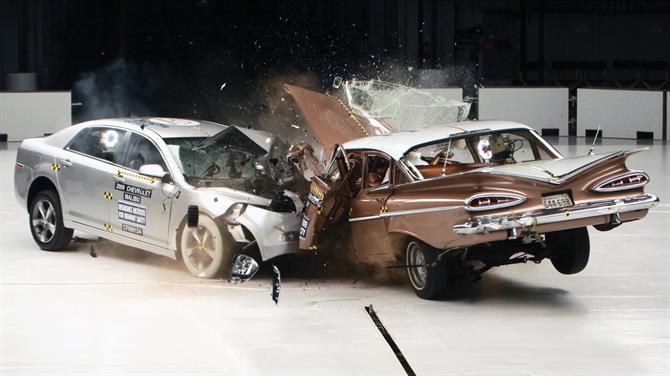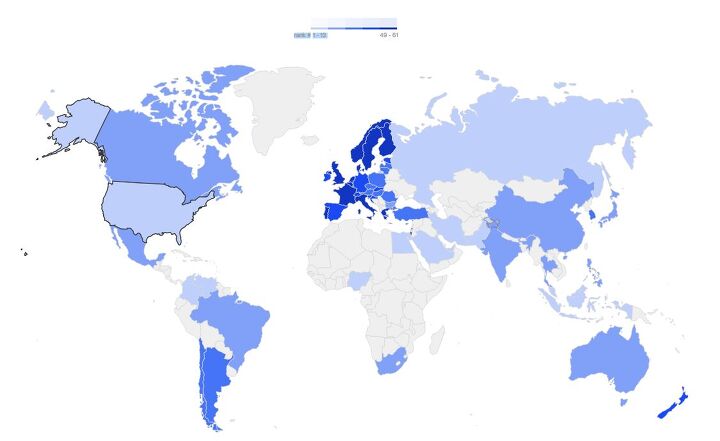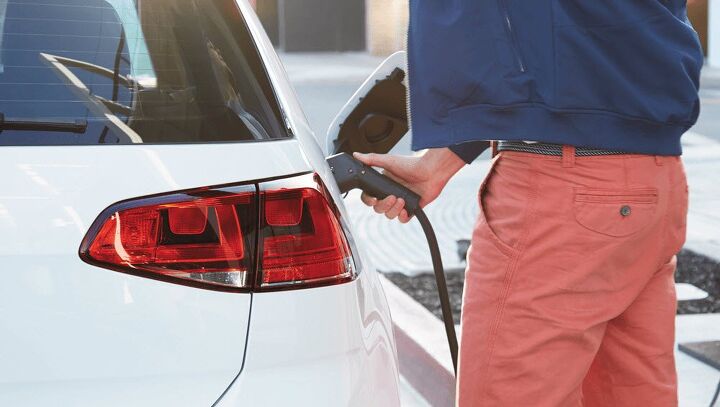#reports
NTSB Releases Preliminary Report on Fatal Uber Crash; Vehicle 'Saw' Victim 6 Seconds Before Impact
The Volvo XC90 that hit Elaine Herzberg on a darkened Tempe, Arizona street was travelling 43 mph at the time of impact. Guided by a combination of cameras, radar sensors, and lidar designed to cut through the gloom, the two-ton SUV “saw” the victim 6 seconds before impact, according to a preliminary report released by the National Transportation Safety Board.
The Volvo, operated by Uber Technologies, applied the brakes 1.3 seconds after impact. However, it wasn’t autonomous software that ended up sending pressure the front and rear pistons. A human did that.
NHTSA Study Confirms New Cars Are Safer, Regulations Not a Scam
You might want to sit down for this one. The National Highway Traffic Safety Administration (NHTSA) released a study this week showing older cars without modern day safety hardware are — and I’m sorry to say this — far more dangerous than newer vehicles. Unbelievable, right?
Of course not. As tacked on and obnoxious as a lot of safety regulations often seem, they are delivering onto us safer automobiles. The old maxim of “they don’t build cars like they used to” is absolutely true, but not in the way your grandfather meant it. According to data compiled from the U.S. government’s Fatality Analysis Reporting System (FARS) between 2012 and 2016, fatal incidents occurred in older model-year vehicles at a much higher rate than their newer counterparts. Not surprisingly, the NHSTA also suggested the severity of an occupant’s injuries increase the older a vehicle gets.
Still, the disparity between the vehicle age groups is surprisingly vast.
Deadly Design: SUV Proliferation a Contributing Factor in Pedestrian Deaths, Study Says
Sport-utility vehicles and crossovers are great for families who want maximized interior volume and a sense of security, but the high-riding vehicles are a double-edged sword. In addition to being less economical than a sedan with a similar footprint, the design doesn’t bode well for pedestrians. In fact, the proliferation of SUVs may be the largest contributing factor to pedestrian fatalities right now. From 2009 to 2016, fatal single-vehicle crashes involving utility vehicles increased by 81 percent.
That’s disconcerting, considering the number of pedestrian killed on U.S. roads declined by 20 percent since 1975, hitting an all-time low in 2009. However, in 2016 the death toll had climbed back up to the highest levels since 1990. The Governors Highway Safety Association estimated nearly 6,000 people were fatally struck by vehicles last year, with around 4,700 of those deaths occurring in urban or suburban areas. Conversely, those same environments only saw 2,959 deaths in 2009.
The increase in fatalities cannot be contributed entirely to the design of SUVs. Distracted driving, encouraged by smart phones and increasingly complicated infotainment systems, has undoubtedly pressed the issue. But, when a strike does occur, the shape of a vehicle still plays an enormous factor.
Global Gas Prices: Where Do We Fit?
You’ve no doubt noticed that gas prices have been creeping up while 2018 progresses. But North America still has it pretty good, especially the United States. Despite fuel prices creeping up to almost $3.00 per gallon, the U.S. still enjoys cheaper gasoline than most of the Western world. Even Canada, which is currently coasting around $4.45 per gallon, manages to undercut the nightmare that is Europe by a wide margin.
North America as a whole spends more on gas per person then practically everywhere else on the globe, though. An affinity for larger vehicles, combined with more time spent behind the wheel, translates into burning more fuel overall. I suppose one could make the argument that we need cheaper petroleum since we use so much of it — just be ready to have someone call you selfish.
For example, the United Kingdom has prices set around $6.59 for a gallon of that good stuff but the average citizen only uses 69.67 gallons a year. However, the average American turns 429 gallons of gasoline into forward motion.
Captain Obvious Finally Arrives: Ride Hailing Actually Congests City Traffic
A recurring theme among ride-hailing executives from the likes of Lyft and Uber is that their platforms will help reduce congestion in the world’s most populous cities. However, anyone actually living in these places will tell you it doesn’t appear to be working. Cities like New York were already clogged with taxi cabs but, instead of seeing all of these drivers buy personal vehicles to enlist as independent contractors for ride-hailing firms, Uber and Lyft brought in new drivers, more vehicles, and fresh competition.
Worse yet, ride-sharing alternatives like Uber Pool have moved people away from buses and trains and placed them in the backseats of cars — further compounding the problem. It turns out city dwellers who already owned an automobile didn’t suddenly decide to get rid of it, and those who were heavily invested in mass transit discovered an affordable car-based alternative.
Incredible News: Report Shows Slight Decline in Tailgate Thefts
You probably never thought you’d see the day when you could look into the eyes of your child and tell them, in your most comforting tone, “Fear not, my dear sweet offspring, the dark clouds that once covered our great nation are breaking. Tailgate thefts have declined slightly this year and we can now see light at the end of the tunnel.”
However, as unbelievable as it sounds, that time has finally come. According to the National Insurance Crime Bureau (NICB), reports of insured tailgate thefts have stabilized since 2014. In fact, such crimes actually decreased by around 5 percent in 2017.
Can an Electric Car Really Save You Money? It Depends on Where You Live
The automotive industry’s gradual shift toward electric vehicles is primarily influenced by global fuel economy mandates. A happy side effect is that consumers benefit from having access to vehicles offering better overall efficiency. This translates into lower running costs and some real savings — once EVs come down in price.
However, there are instances where it might still be cheaper to run a plain Jane internal combustion unit. A new study from the University of Michigan’s Sustainable Worldwide Transportation group explores exactly how cost-effective electric vehicles are and how fuel efficient an internal combustion model would need to be to become the cheaper alternative. The answer, as it turns out, has a lot to do with where you live.
Predicting the Pump: How Much Will We Be Paying for Gas in 2018?
Fueling prices and average economy aren’t exactly the sexiest of automotive topics, but they are the two that will probably influence your life the most directly in the coming year. Expensive gas thrusted countless Americans into economy cars during the early 1980s and 2000s, so any advanced warning would be useful to those considering a new vehicle this year.
Last month, crude prices surpassed $60 per barrel after weekly American output dipped and stockpiles fell. That’s the highest they’ve been in over two-years and, with OPEC cutting production and China hungrier for the black stuff than ever before, prices aren’t expected to drop anytime soon. Does that mean you should nix purchasing that big sport utility vehicle you’ve been eyeballing and option the greener alternative?
Everyone Leases Electric Vehicles Because the Next Crop Will Always Be Better
The automotive industry frames electric vehicles as the future of motoring, but despite a large number of plug-in options already available, the entire idea of owning an electric car is still rather futuristic. Leasing one, however, is far more contemporary.
Growing in popularity, automotive leasing hit a record high in 2016, accounting for 31 percent of all new vehicle sales in the United States. But that’s nothing when you isolate the number of electric cars. U.S. drivers now lease nearly 80 percent of battery-electric vehicles and 55 percent of all plug-in hybrids. Accounting for this trend is a consumer perception that EVs will only get better over time — which isn’t all that different from saying the current fleet isn’t all that impressive.
The IIHS is Hoping For a Bright Future When It Comes to Headlights
Even though headlights have evolved from uniform circles illuminating the roadway in largely the same way to diverse units that look and function very differently, their overall performance has improved immensely. Nobody is going to jump from a 1955 DeSoto to a 2018 Dodge and think “Wow, these headlamps are just terrible.”
However, the International Institute for Highway Safety has been on a two-year mission to make modern headlights look bad and there are two possible explanations as to why. Either the IIHS genuinely believes the current offerings from manufacturers are unsafe, or it’s trying to promote competition within the industry to produce a better bulb. The truth, as usual, is likely somewhere in the middle.
'Tis the Season: Holiday-related Driving Deaths By State
In addition to being needlessly stressful, obligatory holiday travel poses an elevated risk of roadway mishaps. Inclement weather, congested highways, and overtaxed drivers traversing long distances is an exceptionally bad formula. We don’t have to spell it out further; you’ve likely seen seasonal roadside tragedies firsthand and been thankful it wasn’t you.
However, depending on where you’re making your holiday pilgrimage this year, the associated risks could be much higher or lower than someone traveling a few states over. Not all regions are created equal, and some parts of the United States appear to be particularly susceptible to road fatalities during annual festivities.
The IIHS' Updated Criteria Absolutely Devastated Its Top Safety Pick List
While the Insurance Institute for Highway Safety has steadily upgraded its standards over the last two years, the effort hasn’t been without casualties. In a new effort to improve headlight safety and impact protection, the organization has changed its testing criteria for 2018 to include both illumination and passenger-side frontal impacts.
Unfortunately, including these aspects in its final verdict of how safe a vehicle is has removed numerous models from consideration for 2018’s Top Safety Pick+ awards. Last year, 38 vehicles qualified for the safety plus appointment. This year, however, the grand total only came to 15 models — most wearing badges from Hyundai Motor Group and Subaru.
The IIHS makes no apologies for keeping so many cars from receiving top honors. Instead, it claims it was time to heap higher expectations on automakers for items like visibility and passenger safety.
Does the United States Have the World's Best Drivers? Sure, Just Ask Us
If you ask any terrible motorist how skilled they are behind the wheel, the response is often the same. “Oh, I’m a great driver,” they’ll say with a self-assured smile. Meanwhile, you’re left holding back a series of screaming rants that involve first-hand accounts of why their claim couldn’t possibly be accurate. But what about the rest of the country?
As it turns out, the general consensus in the United States is that most people think they’re a fine driver. But things get a little more complicated when you drive into people’s habits behind the wheel. In a recent survey, Driving-tests.org found that 60.8 percent of surveyed Americans thought they were an above-average driver. While that percentage can only be an impossibility, some of the claimed behaviors were slightly better than a comparative sample of international respondents.
Which Segments Incur the Largest (or Smallest) Insurance Losses?
Insurance may be one of the greatest scams ever pulled on the general public, but it’s a very necessary evil. Right around the time the automobile became popular, people starting crashing them into things. By the 1920s, individual states began requiring drivers to purchase insurance — creating a pooled solution that covered at-fault drivers for damages they might be unable to pay otherwise.
However, not all drivers crash and not all vehicles incur the same costs when they take or deliver a beating. Collision losses might be astronomical for high-end sports cars but comparably moderate for midsize pickup trucks. The Insurance Institute for Highway Safety and Highway Loss Data Institute recently compiled the loss averages for hundreds of models, grouping them by segments, to establish how lightly-used autos stack up against each other.
Waymo Drops Comprehensive Self-Driving Safety Assessment, Tries to Educate Public
Autonomous cars have the unique capability to captivate the public’s imagination while simultaneously making them feel uneasy after considering things on a more practical level. A handful of self-driving related accidents, inconsistent development timetables, and a hands-off regulation strategy haven’t helped. But there is a sense that if the populace had a better handle on what went into making the technology work safely, some of their fears would be put to rest.
This week, Waymo — the relatively quiet autonomous vehicle arm of Alphabet Inc. — made an attempt to do just that. While also making a case for itself and the need for self-driving cars, the company released a 42-page outline of how its autonomous systems function. Written without a lot of technical jargon, the reading remains comprehensive and is one of the best attempts we’ve seen from a company to educate the public — rather than dazzle them with lofty promises.





























Recent Comments